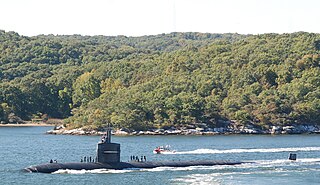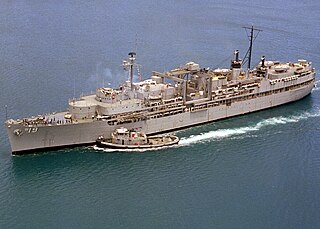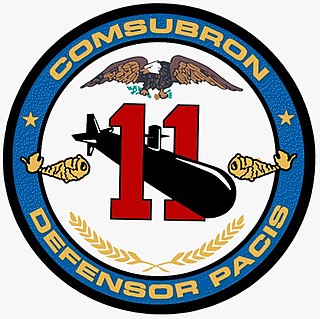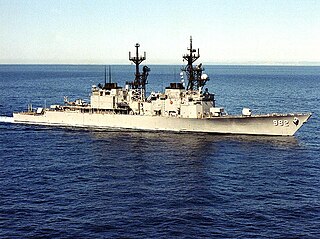
USS Virginia (CGN-38) was a nuclear-powered guided missile cruiser, the lead ship of her class, and the eighth ship of the United States Navy to be named for the Commonwealth of Virginia. She was commissioned in 1976 and decommissioned in 1994.

USS Providence (SSN-719), a Los Angeles-class submarine, is the fifth vessel of the United States Navy to be named for Providence, Rhode Island. The contract to build her was awarded to the Electric Boat Division of General Dynamics Corporation in Groton, Connecticut on 16 April 1979 and her keel was laid down on 14 October 1982. She was launched on 4 August 1984 sponsored by Mrs. William F. Smith, and commissioned on 27 July 1985.

USS Halibut (SSGN-587), a unique nuclear-powered guided missile submarine-turned-special operations platform, later redesignated as an attack submarine SSN-587, was the second ship of the United States Navy to be named after the halibut.

USS Baton Rouge (SSN-689) was a Los Angeles-class nuclear-powered attack submarine which served with the United States Navy. With her keel laid down on 18 November 1972, Baton Rouge was launched on 26 April 1975. She became the second Los Angeles-class submarine to be commissioned, on 25 June 1977. In 1995, she was the first of her class to be decommissioned, after a collision with a Russian Sierra-class submarine.

USS Louisville (SSN-724), a Los Angeles-class submarine, is the fourth ship of the United States Navy to be named for Louisville, Kentucky. The contract to build her was awarded to the Electric Boat Division of General Dynamics Corporation in Groton, Connecticut, on 11 February 1982 and her keel was laid on 24 September 1984. She was launched on 14 December 1985—sponsored by Mrs. Betty Ann McKee, wife of Admiral Kinnaird McKee, Director of Naval Nuclear Propulsion —and commissioned on 8 November 1986 with Captain Charles E. Ellis in command.

USS Plunger (SSN-595), a Permit-class submarine, was the third ship of the United States Navy to be named "plunger", meaning a diver or a daring gambler.

USS Flasher (SSN-613), a Permit-class submarine, was the second ship of the United States Navy to be named for the flasher, a member of the fish family Lobotidae, which have an unusual placement of the second dorsal and anal fins, posteriorly located on the body, close to the tail.

USS San Francisco (SSN-711) is a Los Angeles-class nuclear submarine, the third ship or boat of the United States Navy to be named for San Francisco, California.

The third USS Proteus (AS-19) was a Fulton-class submarine tender in the United States Navy.

USS Simon Lake (AS-33) was the lead ship of her class of submarine tenders in the United States Navy, named for Simon Lake, a pioneering designer of early submarines.

USS Tautog (SSN-639), a Sturgeon-class attack submarine, was the second ship of the United States Navy to be named for the tautog, a wrasse commonly found along the Northern Atlantic coast. The submarine was in service from 17 August 1968 to 31 March 1997.

USS Guitarro (SSN-665), a Sturgeon-class submarine, was the second ship of the United States Navy to be named for the guitarro, a ray of the guitarfish family.

USS Albuquerque (SSN-706) was a Los Angeles-class attack submarine of the United States Navy. She was the second U.S. warship to be named for Albuquerque, New Mexico. The contract to build her was awarded to the Electric Boat Division of General Dynamics Corporation in Groton, Connecticut, on 31 October 1973 and her keel was laid down on 27 December 1979. She was launched on 13 March 1982, sponsored by Nancy L. Domenici, and commissioned on 21 May 1983.

USS Puffer (SSN-652), a Sturgeon-class nuclear attack submarine, was the second ship of the United States Navy to be named for the pufferfish, a saltwater fish with toxic spines that can inflate its body with water or air and is one of the most poisonous vertebrates in the world.

USS Sunfish (SSN-649), a Sturgeon-class attack submarine, was the second ship of the United States Navy to be named for the ocean sunfish, a marine species having a deep body truncated behind, and high dorsal and anal fins.

USS Key West (SSN-722), a Los Angeles-class submarine, is the third ship of the United States Navy to be named after Key West, Florida.

USS Columbus (SSN-762) is a Los Angeles-class nuclear powered fast attack submarine and the second vessel of the United States Navy to be named for Columbus, Ohio. The contract to build her was awarded to the Electric Boat Division of General Dynamics Corporation in Groton, Connecticut, on 21 March 1986 and her keel was laid down on 9 January 1991. She was launched on 1 August 1992 sponsored by Mrs. Margaret DeMars, wife of Admiral Bruce DeMars and commissioned on 24 July 1993.

USS Emory S. Land (AS-39) is a United States Navy submarine tender and the lead ship of her class. She was named for Admiral Emory S. Land.

Submarine Squadron 11 is a squadron of submarines based at Point Loma Submarine Base, San Diego, California, United States. Submarine Squadron 11 was commissioned July 1, 1986, aboard her flagship, McKee, at Naval Submarine Base Point Loma, San Diego. Their missions include anti-submarine, anti-surface, strike, special and mine warfare, intelligence, surveillance and reconnaissance. The squadron currently consists of four Los Angeles-class submarines for deployments to the Western Pacific, Indian Ocean and the Persian Gulf.





















